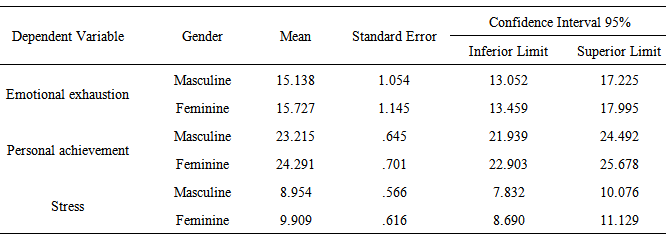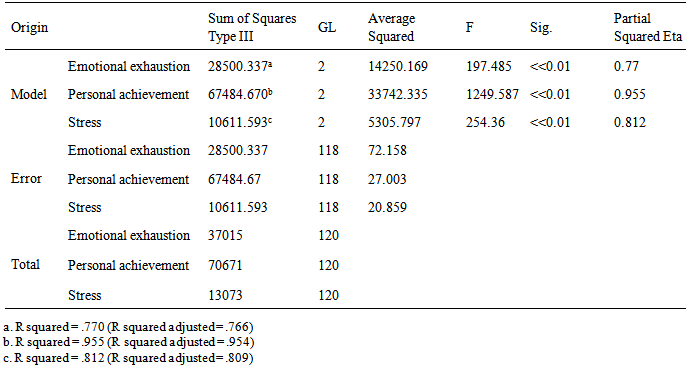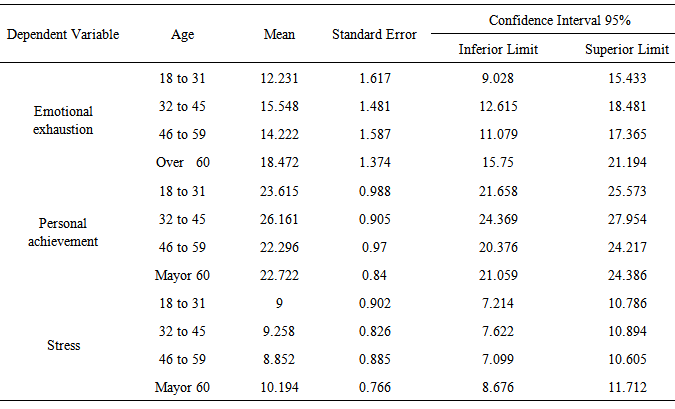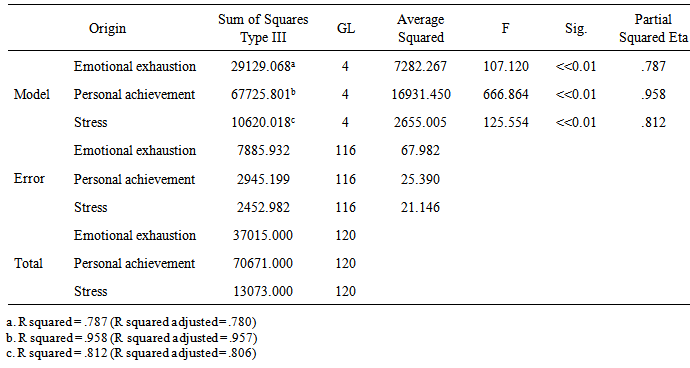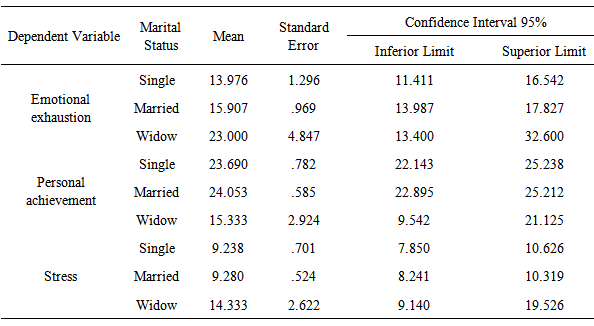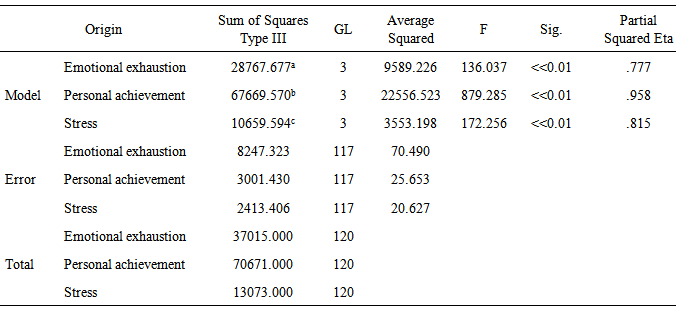-
Paper Information
- Previous Paper
- Paper Submission
-
Journal Information
- About This Journal
- Editorial Board
- Current Issue
- Archive
- Author Guidelines
- Contact Us
International Journal of Applied Psychology
p-ISSN: 2168-5010 e-ISSN: 2168-5029
2014; 4(6): 223-228
doi:10.5923/j.ijap.20140406.03
Profile Analysis of Burnout in Yucatecan Microentrepreneurs
Jorge E. Madero, Hermila A. Ulibarri, Andres M. Pereyra, Jorge A. Quintal
Postgraduate Studies of the Department of Industrial Engineering, Instituto Tecnologico de Merida, Mexico
Correspondence to: Jorge E. Madero, Postgraduate Studies of the Department of Industrial Engineering, Instituto Tecnologico de Merida, Mexico.
| Email: |  |
Copyright © 2014 Scientific & Academic Publishing. All Rights Reserved.
This research paper had the main objective of knowing if the burnout profile is different according to gender, age and marital status of micro business owners of the town of Uman, Yucatan. The selected sample was of 120 owners of family owned micro businesses. The theoretic basis of stress was taken from the studies of Freudenberg (1974), Maslach (1978) and Meier (1994) in order to define the Burnout construct. The instrument used to determine the level of Burnout Syndrome was the Maslach Burnout Inventory (MBI). A descriptive investigation was made using a Multivariate Generalized Linear Model for each fixed factor of gender, age and marital status. The dependent variables that were used were emotional exhaustion, personal achievement and stress. The results show that women and people older than 60 years of age, experience higher levels of stress, people between the ages of 18 and 31 are more likely to get high scores in personal achievement and the widowed, marital status affects their personal achievement rate and it seems to be a risk factor for emotional exhaustion and stress.
Keywords: Profiling Burnout, Occupational Stress, Small Family Business
Cite this paper: Jorge E. Madero, Hermila A. Ulibarri, Andres M. Pereyra, Jorge A. Quintal, Profile Analysis of Burnout in Yucatecan Microentrepreneurs, International Journal of Applied Psychology, Vol. 4 No. 6, 2014, pp. 223-228. doi: 10.5923/j.ijap.20140406.03.
Article Outline
1. Introduction
- Burnout has caused passionate debates among authors [31] Warnath, in 1979, discussed over the veracity of the existence of the syndrome of being burnt out or was it an existential crisis that health professionals went through in those years. In its origins, his study was centered in health care personnel such as nurses and orderlies.Burnout has its origins in the 70s’, in that time, studies about stress dominated the scientific topics and burnout was a form of chronic stress in the workplace mixed with other factors [9].In the beginning, authors like Emener, W. (1979) consider burnout as an affectation suffered by people who were really committed to their work-related activities and that there was a relationship between this and the patients, in other investigations Helliwell (1981) mentions that the people most vulnerable to Burnout are those who try to be perfect in their jobs.The most quoted burnout definition from the 70s’ is that of Freudenberger, (1974). According to this author, burnout is explored by physical signs and conduct indicators (cognitive factors were a topic of debate). Freudenberger mentions having had the sensation of being burnt by his job and he questions the nature of burnout and one of the questions is: “What is Burnout?” This author defines burnout as: "to fail, wear out, or become exhausted by making excessive demands on energy, strength, or resources." Burnout is that sensation of working hard and harder for a longer period of time; however, having the feeling that one hasn’t gotten ahead with work [7].The first output of burnout was the outcome of studies about nurses [13] with their patients, nowadays this is a studied topic in different social groups such as priests [18], professors [1], athletes [3], sales persons [30], police officers [4] and teachers [19].One of the national authorities when it comes to studying burnout is Dr. Maslach. In her first studies, Maslach (1978) she discusses the role of the client as an important factor that can help prevent or develop in great measure emotional exhaustion. According to this author, emotional exhaustion burnout is the result of unsuccessfully handling emotional stress that is caused by intense participation with clients.Maslach’s most important contribution is the Maslach Burnout Inventory (MBI), especially in its validation in different populations [21]. The MBI is the most well-known and used instrument to evaluate the burnout syndrome. Since its publishing, validity studies have been made with other scales and instruments, one study worth rescuing is that of Meier, (1984) in which multi-feature and multi-method methods of evaluation are used for the burnout construct. According to Greenglass & Burke (1988) the MBI evaluates the frequency and intensity of feelings and is composed by three factors: the emotional exhaustion, which refers to feelings of being emotionally overextended and exhausted by others, depersonalization, refers to a insensitive response towards people who are the receivers of one’s services, and finally, low personal achievement, refers to the decrease of one of the competence feelings and the good results in the labor of oneself with other people. Burnout is a response to chronic emotional tension of dealing with other people who have problems, particularly, when they’re difficult problems.Since its publishing, MBI has been studied and other authors have proven evidence about the three factor model [16]. It’s worth mentioning that many of Maslach’s investigations are not of public domain and this is highly criticized by other authors who doubt of the reliability of the test [25], these have proposed other means of measuring such as the “Questionnaire for the evaluation of Burnout Syndrome in the workplace” (CESQT for its Spanish acronyms).Recent studies of burnout have been generalized, studies done in Spain [24], America [29], and México[26] suggest that burnout has reached high affectation levels in the economically active population, in fact, evidence of the presence of this ailment has been found in workers belonging to departments whose main activities are not related with direct contact with the public.In Merida, Yucatan, Mexico, research has been made to describe and analyze the consequences that work stress has caused in the working population of several areas of economic activities. For example, research indicates that there’s a relation between work stress and productivity [26]. Gender has been studied by different authors who have found a variety of results since 1970. According to Caccese & Mayerberg, (1984) women experience emotional exhaustion and low personal achievement more frequently. The results of recent studies tend to be permanent, women experience emotional exhaustion in greater quantities compared to men [27], and the latter tend to depersonalize more than women [3]. Differences have also been found among age groups and education level [27]. As it can be observed burnout is a highly studied subject and there are still inconsistencies in the study methodology. Some authors critique the supposed orthogonality of the MBI factors [25], it’s worth asking: if the factors are orthogonal, why are they added up for a final score? This research considers the syndrome’s factors as a profile in which its factors interact simultaneously in whoever is suffering it, therefore, the more adequate analysis under this model is the one factor multivariate Generalized Linear Model [15]. Taking this into consideration, the objective of this investigation is to analyze if there are differences between, age, gender and marital status, and the emotional exhaustion, personal achievement and stress factors of the burnout syndrome.
2. Method
2.1. Investigation Type and Design
- A descriptive investigation was made, using a multivariate profile analysis with three sociodemographic variables: Age, gender and marital status, the study is of a transversal type since the obtained information was measured in one moment only [12], these variables were considered as independent samples of heterogenic sizes and the burnout syndrome factors were considered as independent variables in the general linear model but dependent with each other because they’re part of a linear combination of the total scale score.
2.2. Universe and Sample
- According to the Mexican Institute of National Geography Statistics and Information, Instituto Nacional de Geografía Estadística e Informática, (2010) there are in Uman, Yucatan, 266 businesses under the economic activity 46111, which is businesses dedicated towards retail such as convenience stores.A non-probabilistic sampling was made using accidental and quota sampling and it was concluded that the studied sample would be determined by the total number of family businesses that were open and available at the moment of performing the field work in the town, totaling in 120 surveys were made to the owners of the family owned microbusinesses.The average age of the surveyed people is of 47.85 years with a standard deviation of ±18.73 distributed in the town of Dzibicab (4.2%), Oxolon (2.5%) and the main being Uman (93.3%). Out of the surveyed sample 54.2% were men and 45.8% were woman, and 37.5% of the total sample has at the most a concluded elementary education, 62.5% of them are married, 35% are single and 2.5% are divorced.Regarding the distribution of the sample according to the age variable, 21.7% are between 18 and 31 years old, 25.8% between the ages of 32 and 45, 22.5% are between 46 and 59 years old and 30% are over 60 years of age.
2.3. Determination of the Study Variables
- BS profile: this is composed by the following factors, emotional exhaustion, personal achievement and stress. It’s a dependent variable for the generalized linear model and a continuous, finite and polytomicvariable because it has different values. It’s an attributive variable due to the fact that it’s already a characteristic of the population.The variables: gender, marital status and age are independent variables for the generalized linear model. Gender is a binary and attributive variable, marital status and age are polytomic attributive variables.
2.4. Instrument
- The instrument made by two validity phases. The validity of content was determined by the strict revision of three experts, who made recommendations according to the hypothesis and research’s main objective, as well as the adaptation of the instrument to the environment in which it was applied. The construct validity was made by an analysis of the principal components with an oblique rotation. For the three factors of the main component analysis confidence calculations were made, the self-values and the explained variance percentage are given.The total scale reliability is of 0.751 which explains the 49.30% of the variance. The emotional exhaustion factor has a reliability of 0.833 which explains the 26.54% in variance, the personal achievement factor has a reliability of 0.749 and explains the 14.902% of variance, and finally the stress factor has a reliability of 0.628 and explains the variance of 7.860%.
2.5. Procedure
- A field study was made for the application of the instrument the microbusinesses that were formed by a family society. The item’s psychometric properties were analyzed and the pertinent adjustments were made to the scale to obtain a greater theoretic and numeric clarity of the variance and reliability percentage.Data exploration analysis were made to know the atypical data, the lost values and the measurement levels of variables. Frequencies were made to know the frequency distribution in each of the independent samples of the model. Descriptive statistics were made to know the mean and the standard deviation of the scores of each of the studied samples.A generalized multivariate linear model was designed for each of the independent variables; the independent variables were taken as fixed factors and post hoc analysis of the Bonferroni confidence intervals were made for the main effects of the variables. The calculations for the size of effect of each of the variables and adjusted models were also made.
3. Results
- An analysis was made to know if there are significant statistic differences between age, gender and marital status. For each of the, descriptive and multivariate analysis were made with the burnout syndrome profile. A post hoc analysis was made to know the differences between the groups with a significance level of 0.05.According to the gender variable, it was found with the multivariate analysis that there were significant statistic differences. The Wilks F Lambda statistic is significant, however, other statistic measures like the Roy major root are given, which is used for analyzing heterogenic groups.It can be observed in Table 1, due to the post hoc analysis, that women have higher scores than men, when it comes to stress and personal achievement, however, emotional exhaustion can be experienced equally by men and women.The values of the partial squared eta from table 2, r squared and r squared adjusted, represent the value of variance which is explained in each of the factors influence by the gender variable. Elevated proportions are observed, this implies that the gender variable has a strong influence in the burnout syndrome profile.In table 3 we can see that the analysis by age groups shows significant differences with the multivariate statistical analysis. Every level of significance is below 0.01. A post hoc analysis of the couples’ comparisons was made, significant differences (p 0.024) can be observed in table 4 for the emotional exhaustion factor among the age groups of 18 to 31years and for those over 60 years of age. In the personal achievement factor, the post hoc analysis presents significant differences in the age groups of 32 to 45 and 46 to 59 (p. 0.026) and the age groups of 32 to 45 and over 60 (p. 0.037). The stress factor showed no significant differences.In table 5 the r squared and the partial eta value squared provide information about the variance quantity of age as a variable with a lot of influence to explain the burnout syndrome. The model values are significantly lower to 0.01.It can be observed in table 6 that according to the marital status variable, it was found that in the multivariate analysis there are significant statistical differences. The Wilks Lambda F statistic is significant, however, other statistics have been provided, which are used for analyzing heterogenic groups, such as the Roy Mayor Root.Table 8 shows that in a post hoc analysis, one can observe that there are significant statistical differences between the married and the widowed group (p- 0.012) and the single and widow group too (p. 0.020) for the interpersonal relationship factor only. No significant differences were found among the groups for neither the emotional exhaustion factor nor the stress factor.It’s worth mentioning that through the application of different analysis thanks to a generalized linear model, shown in table 9, each variable presents the aforementioned results. However in a model in which one can observe the influence of the three variables, there are no observable significant differences for the Main Effect Models and the Main Effects with double Interaction models.
|
|
|
|
|
|
|
|
|
4. Conclusions
- Results differ in theory with the research that uses MBI factors as orthogonal, in this study, emotional exhaustion related to gender is not significant, but it is when related to age. This is an interesting fact, because one can assume that emotional exhaustion is experienced equally by men and women. However, women tend to have a higher score when it comes to Personal achievement and stress.When it comes to age, people between the ages of 18 and 31 years old are more likely to get high scores in personal achievement, this can be interpreted as a type of frustration in young people. Being a widow seems to be a risk factor for emotional exhaustion and stress.
 Abstract
Abstract Reference
Reference Full-Text PDF
Full-Text PDF Full-text HTML
Full-text HTML